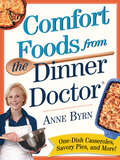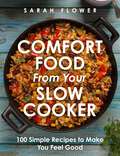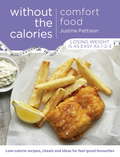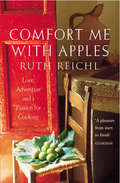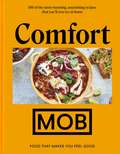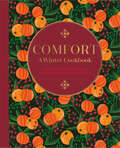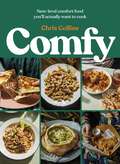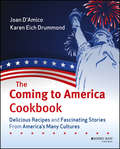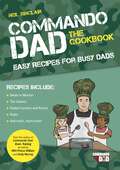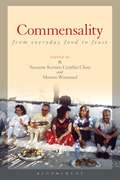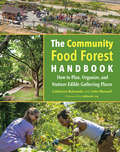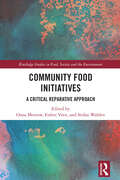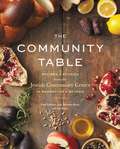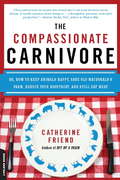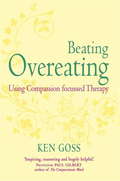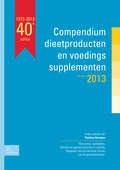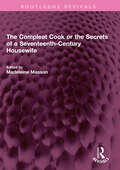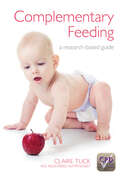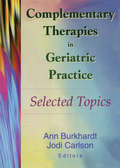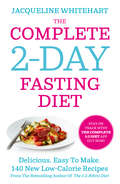- Table View
- List View
Comfort Food from the Dinner Doctor
by Anne ByrnOne dish. A few simple supermarket ingredients. That's all it takes for the Dinner Doctor® to work her magic. Here, beloved author Anne Byrn offers twenty inventive recipes for easy-to-make, delicious one-dish comfort foods you can put together in fifteen minutes or less, and then plop in the oven. Fancy a Parmesan Chicken and Biscuit Pie tonight? All you’ll need is a rotisserie chicken, a bag of frozen vegetables, cream, frozen biscuits, and some pre-grated Parmesan cheese—and dinner is served.Note: Comfort Foods from the Dinner Doctor is an excerpt from Anne Byrn’s bestselling The Dinner Doctor.The Dinner Doctor is a registered trademark of Anne Byrn.
Comfort Food from Your Slow Cooker: Simple Recipes to Make You Feel Good
by Sarah FlowerSave money and time with the most nourishing, comforting and delicious one-pot recipesComfort Food from Your Slow Cooker contains more than eighty recipes that are pure delicious joy, save you time and money, and get the best out of your slow cooker.These recipes have delighted families for generations, and will make sure even the fussiest of eaters are satisfied. They include:· Rustic Coq au Vin· Comforting Beef Stew with Dumplings· Garlic Potato & Gruyére Layer Cake· Bacon-Wrapped Pork Tenderloin with Creamy Mustard Sauce· Spiced Toffee Apple & Almond CrumbleDeveloped specifically with your family's needs in mind to help you eat nourishing, comforting food without breaking the bank, these much-loved dishes can fit around your busy schedule whether you've got ten minutes in the morning before you head off for work or a couple of hours before picking your kids up.Sarah Flower is a leading nutritionist and the author of The Keto Slow Cooker, Slow Cooker Family Classics and The Healthy Slow Cooker Cookbook.
Comfort Food Without the Calories: Low-calorie Recipes, Cheats and Ideas for Feel-Good Favourites
by Justine PattisonComforting low-calorie recipes that make losing weight as easy as 1-2-3COMFORT FOOD WITHOUT THE CALORIES takes all the hassle out of cooking your favourite feel-good food, the low-cal way.In the WITHOUT THE CALORIES series, bestselling recipe writer Justine Pattison's 123 Plan provides an easy-to-follow approach to your daily meals. Each calorie-counted recipe has been triple tested, with tips and ideas to enhance your low-cal cooking experience, plus additional nutritional information to suit any diet regime.
Comfort Me With Apples: Love, Adventure and a Passion for Cooking (Thorndike Press Large Print Nonfiction Ser.)
by Ruth ReichlIn this delightful sequel to her bestseller Tender at the Bone, the beloved food writer Ruth Reichl returns with more tales full of love, life, humour and marvellous meals. Ruth Reichl's pursuit of good food and good company leads her to New York and China, France and Los Angeles. She cooks and dines with world-famous chefs and the three star aristocracy of French cuisine, and her accounts of these meetings range from the madcap to the sublime. Reichl lovingly recreates all her marvellous meals in such succulent detail that readers will yearn from truffles in Provence and shrimp in Beijing. Throughout it all, Reichl is unafraid, even eager, to poke holes in the pretensions of food critics, making each and every course a hilarious and instructive occasion for novices and experts alike. She shares some of her first recipes so readers can make the Dry-Fried Shrimp she first tasted in China, or the Dacquoise served at the end of a magical visit to a Paris bistro. Reichl also shares the intimacies of her personal life in a style so honest and warm that readers will feel they are enjoying a cosy dining-table conversation with a friend. In Comfort Me With Apples, Reichl again demonstrates her inimitable ability to combine food writing, humour and memoir into an art form.
Comfort MOB: Food That Makes You Feel Good
by MOB KitchenIt's the return of the MOB! This time celebrating all things crispy, squidgy, cheesy, spicy, warming, sticky, nourishing... all the flavours, textures and feel of comfort pulled together in one book, 100 recipes.'This book is pure delicious joy....this feel-good collection, with delicious twists crammed into every recipe. Perfect for autumnal cooking and colder nights.' BBC Good FoodCOMFORT MOB is a celebration of hearty dishes from around the world that warm, soothe and fill us. Spending time in the kitchen recreating comfort is a way to indulge in dishes from the past and find new flavour and texture combinations that appeal to our senses.Featuring old-school bangers with a MOB Kitchen twist such as Roast Garlic Chicken Pie or Beef Brisket Lasagne, and modern dishes like Sriracha Crispy Tofu or Coca Cola Chicken Wings, COMFORT MOB encourages you to indulge every palate and craving in a fun, affordable and achievable way. If you're in a hurry but need a quick dose of comfort, recipes like the Grilled Halloumi and Peach Burger with Chipotle Mayo or Ben's Dad's Puttanesca will hit the spot in no time. For an extra dose of comfort, follow Mob's recipes for making your own pasta, focaccia and gnocchi to take your meal to the next level. Mob have also cooked up some cosy dessert recipes to finish - try Miso Sticky Toffee Pudding or extra-oozy Chocolate Jaffa Pool. COMFORT MOB is a nod to homeliness and cosy nights spent cooking with friends and family, recapturing the feeling of better, safer times with food that loves you back.
Comfort: A Winter Cookbook
by Ryland Peters & SmallWhen the weather turns cold, what could be better than sitting by the fire and enjoying home-cooked food with family and friends. From comforting casseroles and bakes to seasonal snacks and warming drinks — this is the ideal cook’s companion for the winter months. Make the most of being holed up indoors and prepare some warming Snow Day Snacks. Enjoy sharing tasty treats such as Creamy Pancetta and Onion Tart or Cheddar and Cider Fondue. When it’s chilly outside, what we naturally crave is comforting food. In Cold Day Comforts you’ll find plenty of warming dishes including Spiced Pumpkin and Coconut Soup or Salmon Broccoli and Potato Gratin with Pesto. What better way to spend an icy afternoon than preparing a delicious meal to share with family and friends. Fireside Feasts is full of great ideas for winter entertaining. Try a Braised Pot Roast with Red Wine, Rosemary and Bay or Slow-cooked Lamb Shanks with Lentils. Make the most of the finest seasonal ingredients the winter has to offer and prepare healthy and satisfying Winter Salads. Choose from recipes such as Steak and Blue Cheese Salad or Roast Butternut Squash Salad with Spiced Lentils, Goat Cheese and Walnuts. Whether you enjoy a luxurious dessert or a slice of cake in front of the fire, there are plenty of delicious options to choose from in Indulgent Treats. Try Pecan Cheesecake Swirl Brownies, Arctic Roll with Vanilla and Chocolate or Brown Sugar Pavlova with Cinnamon Cream and Pomegranate. Finally, in A Cup of Cheer there are plenty of ideas for festive drinks and toddies. Relax at home with a warming Chocolate Marshmallow Melt or enjoy winter entertaining with a delicious Mulled Wine, guaranteed to make any holiday gathering a success.
Comfy
by Chris Collins Don’t Go HeartMake your comfort food dreams come true with Comfy, the essential cookbook for simple, indulgent and joyful dinners to make your heart sing. Creator of the renowned food blog Don't Go Bacon My Heart, Chris Collins has curated a collection of feel-good dinners that put flavour first, combining accessible ingredients, straightforward methods and failproof cooking advice for unforgettable meals every time. - Burrata Caprese Pasta - Cottage Pie Baked Potatoes - Easy Bloomer Bread Pizza - Brown Butter Gnocchi with Sage and Butternut Squash - Soul Soothing Chicken Orzo Soup - Roasted Sweet Potato Salad with Poppy Seed Dressing - Harissa Halloumi Skewers - Katsu Curry Everything from plates piled high with pasta, takeaway classics reinvented for the home kitchen, set-and-forget slow-cooker favourites and dinner-worthy soups and salads. This is year-round food that you'll never want to stop cooking. The only book you need to create cosy and delicious evenings for you, your family and your friends.
The Coming to America Cookbook: Delicious Recipes and Fascinating Stories from America's Many Cultures
by Joan D'Amico Karen E. DrummondCOOK UP A HEAPING DISH OF CULTURE WITH TASTY RECIPES FROM AMERICAN IMMIGRANTS Who knew culture could be so delicious? In THE COMING TO AMERICA COOKBOOK, you'll discover how America's immigrants have lived and dined over the centuries. This scrumptious survey of a wide variety of cuisine--Mexican, Irish, Chinese, Moroccan, Turkish, Ethiopian, Nigerian, and many more--blends together an appetizing mix of kid-friendly recipes and fun food facts throughout each chapter. Kids will have a great time learning about each culture's distinctive foods and traditions while they cook up easy and yummy recipes, including: NAAN, a bread made with yogurt, which is a staple of Indian cooking SAVORY SHRIMP OVER RICE, a recipe from Northern Italy passed down through generations BRATWURST WITH SAUERKRAUT, a favorite dish of Wisconsin, where many Germans settles in the nineteenth century BANANA STRAWBERRY BATIDOS, icy Cuban drinks that are as common as cola in cities with many Cuban residents, such as Miami DUTCH WINDMILL COOKIES, which are traditionally made in the Netherlands at Christmas time THE COMING TO AMERICA COOKBOOK also includes information on cooking tools and skills, with important rules for kitchen safety and cleaning up.
Commando Dad: Easy Recipes for Busy Dads
by Neil SinclairSwapping his beret for a chef’s hat, Neil Sinclair, author of the bestselling Commando Dad: Basic Training, is back. Bursting with simple, healthy recipes, his cookbook will help you master the kitchen basics and prepare meals the family will love. Let the cooking adventures commence!
Commensality: From Everyday Food to Feast
by Susanne Kerner Cynthia Chou Morten WarmindThroughout time and in every culture, human beings have eaten together. Commensality - eating and drinking at the same table - is a fundamental social activity, which creates and cements relationships. It also sets boundaries, including or excluding people according to a set of criteria defined by the society. Particular scholarly attention has been paid to banquets and feasts, often hosted for religious, ritualistic or political purposes, but few studies have considered everyday commensality.Commensality: From Everyday Food to Feast offers an insight into this social practice in all its forms, from the most basic and mundane meals to the grandest occasions. Bringing together insights from anthropologists, archaeologists and historians, this volume offers a vast historical scope, ranging from the Late Neolithic period (6th millennium BC), through the Middle Ages, to the present day. The sixteen chapters include case studies from across the world, including the USA, Bolivia, China, Southeast Asia, Iran, Turkey, Portugal, Denmark and the UK. Connecting these diverse analyses is an understanding of commensality's role as a social and political tool, integral to the formation of personal and national identities.From first experiences of commensality in the sharing of food between a mother and child, to the inaugural dinner of the American president, this collection of essays celebrates the variety of human life and society.
Commensality: From Everyday Food to Feast
by Susanne Kerner Cynthia Chou Morten WarmindThroughout time and in every culture, human beings have eaten together. Commensality - eating and drinking at the same table - is a fundamental social activity, which creates and cements relationships. It also sets boundaries, including or excluding people according to a set of criteria defined by the society. Particular scholarly attention has been paid to banquets and feasts, often hosted for religious, ritualistic or political purposes, but few studies have considered everyday commensality.Commensality: From Everyday Food to Feast offers an insight into this social practice in all its forms, from the most basic and mundane meals to the grandest occasions. Bringing together insights from anthropologists, archaeologists and historians, this volume offers a vast historical scope, ranging from the Late Neolithic period (6th millennium BC), through the Middle Ages, to the present day. The sixteen chapters include case studies from across the world, including the USA, Bolivia, China, Southeast Asia, Iran, Turkey, Portugal, Denmark and the UK. Connecting these diverse analyses is an understanding of commensality's role as a social and political tool, integral to the formation of personal and national identities.From first experiences of commensality in the sharing of food between a mother and child, to the inaugural dinner of the American president, this collection of essays celebrates the variety of human life and society.
The Community Food Forest Handbook: How to Plan, Organize, and Nurture Edible Gathering Places
by Catherine Bukowski John Munsell LaManda JoyCollaboration and leadership strategies for long-term success Fueled by the popularity of permaculture and agroecology, community food forests are capturing the imaginations of people in neighborhoods, towns, and cities across the United States. Along with community gardens and farmers markets, community food forests are an avenue toward creating access to nutritious food and promoting environmental sustainability where we live. Interest in installing them in public spaces is on the rise. People are the most vital component of community food forests, but while we know more than ever about how to design food forests, the ways in which to best organize and lead groups of people involved with these projects has received relatively little attention. In The Community Food Forest Handbook, Catherine Bukowski and John Munsell dive into the civic aspects of community food forests, drawing on observations, group meetings, and interviews at over 20 projects across the country and their own experience creating and managing a food forest. They combine the stories and strategies gathered during their research with concepts of community development and project management to outline steps for creating lasting public food forests that positively impact communities. Rather than rehash food forest design, which classic books such as Forest Gardening and Edible Forest Gardens address in great detail, The Community Food Forest Handbook uses systems thinking and draws on social change theory to focus on how to work with diverse groups of people when conceiving of, designing, and implementing a community food forest. To find practical ground, the authors use management phases to highlight the ebb and flow of community capitals from a project’s inception to its completion. They also explore examples of positive feedbacks that are often unexpected but offer avenues for enhancing the success of a community food forest. The Community Food Forest Handbook provides readers with helpful ideas for building and sustaining momentum, working with diverse public and private stakeholders, integrating assorted civic interests and visions within one project, creating safe and attractive sites, navigating community policies, positively affecting public perception, and managing site evolution and adaptation. Its concepts and examples showcase the complexities of community food forests, highlighting the human resilience of those who learn and experience what is possible when they collaborate on a shared vision for their community.
Community Food Initiatives: A Critical Reparative Approach (Routledge Studies in Food, Society and the Environment)
by Oona Morrow Esther Veen Stefan WahlenThis book examines a diverse range of community food initiatives in light of their everyday practices, innovations, and contestations. While community food initiatives aim to tackle issues like food security, food waste, or food poverty, it is a cause for concern for many when they are framed as the next big "solution" to the problems of the current industrialised food system. They have been critiqued for being too neoliberal, elitist, and localist; for not challenging structural inequalities (e.g. racism, privilege, exclusion, colonialism, capitalism); and for reproducing these inequalities within their own contexts. This edited volume examines the everyday realities of community food initiatives, focusing on both their hopes and their troubles, their limitations and failures, but also their best intentions, missions, and models, alongside their capacity to create hope in difficult times. The stories presented in this book are grounded in contemporary theoretical debates on neoliberalism, diverse economies, food justice, community and inclusion, and social innovation, and help to sharpen these as conceptual tools for interrogating community food initiatives as sites of both hope and trouble. The novelty of this volume is its focus on the everyday doings of these initiatives in particular places and contexts, with different constraints and opportunities. This grounded, relational, and place-based approach allows us to move beyond more traditional framings in which community food initiatives are either applauded for their potential or criticized for their limitations. It enables researchers and practitioners to explore how community food initiatives can realize their potential for creating alternative food futures and generates innovative pathways for theorising the mutual interplay of food production and consumption. This volume will be of great interest to students and scholars of critical food studies, food security, public health, and nutrition as well as human geographers, sociologists, and anthropologists with an interest in food.
Community Food Initiatives: A Critical Reparative Approach (Routledge Studies in Food, Society and the Environment)
This book examines a diverse range of community food initiatives in light of their everyday practices, innovations, and contestations. While community food initiatives aim to tackle issues like food security, food waste, or food poverty, it is a cause for concern for many when they are framed as the next big "solution" to the problems of the current industrialised food system. They have been critiqued for being too neoliberal, elitist, and localist; for not challenging structural inequalities (e.g. racism, privilege, exclusion, colonialism, capitalism); and for reproducing these inequalities within their own contexts. This edited volume examines the everyday realities of community food initiatives, focusing on both their hopes and their troubles, their limitations and failures, but also their best intentions, missions, and models, alongside their capacity to create hope in difficult times. The stories presented in this book are grounded in contemporary theoretical debates on neoliberalism, diverse economies, food justice, community and inclusion, and social innovation, and help to sharpen these as conceptual tools for interrogating community food initiatives as sites of both hope and trouble. The novelty of this volume is its focus on the everyday doings of these initiatives in particular places and contexts, with different constraints and opportunities. This grounded, relational, and place-based approach allows us to move beyond more traditional framings in which community food initiatives are either applauded for their potential or criticized for their limitations. It enables researchers and practitioners to explore how community food initiatives can realize their potential for creating alternative food futures and generates innovative pathways for theorising the mutual interplay of food production and consumption. This volume will be of great interest to students and scholars of critical food studies, food security, public health, and nutrition as well as human geographers, sociologists, and anthropologists with an interest in food.
The Community Table: Recipes & Stories from the Jewish Community Center in Manhattan & Beyond
by Katja Goldman Lisa Rotmil Judy Bernstein Bunzl JCC ManhattanAcross the continent, JCCs are cultural epicenters of modern Jewish life. The buildings are hives of activity; at any given moment, hundreds of people of all ages, backgrounds, interests, and opinions gather to engage in a myriad of activities. And nothing says community more than food.While sitting down to enjoy a meal together is undeniably bonding, working together to prepare it is even more so. Now, three chefs who are longstanding members of the JCC Manhattan share classic recipes such as Weekly Challah, Latkes Four Ways, and Pumpkin Rugelach, plus an inspiring selection of contemporary dishes with a farm-to-table emphasis and international flavors: Fig and Fennel Bread, Iraqi Lamb Burgers, Brussels Sprouts with Pomegranate and Citrus Glaze, and much more. Holiday menu suggestions and a complete chart grouping recipes by dietary restriction (meat, pareve, dairy) are included as well.With anecdotal contributions from JCCs all around the country, this cookbook highlights the JCC's vibrant, eclectic community-and celebrates all of its many flavors.
The Compassionate Carnivore: Or, How to Keep Animals Happy, Save Old MacDonald's Farm, Reduce Your Hoofprint, and Still Eat Meat
by Catherine FriendCatherine Friend tackles the carnivore's dilemma, exploring the contradictions, nuances, questions, and bewildering choices facing today's more conscious meat-eaters. The Compassionate Carnivore is "perfect for people who would like to eat meat but have moral, ethical, or health concerns about doing so” (Marion Nestle, What to Eat). Based on her own personal struggle, Friend's original, witty take on the meat and livestock debates shows consumers how they can be healthy and humane carnivores, too.
The Compassionate Mind Approach to Beating Overeating: Series editor, Paul Gilbert
by Kenneth GossThis self-help book explores the problems created by having ready access to high fat foods designed to taste good. Because we evolved in conditions of relative scarcity we have few natural food inhibitors and so most diet books try to encourage people to inhibit their eating by highly rule governed behaviours which have to be constantly worked at. However, this can lead to various forms of self-criticism which can undermine efforts at self-control. As a result our relationship with eating can be complex, multifaceted and problematic.Beating Overeating Using Compassion Focused Therapy uses Compassion Focused Therapy - a groundbreaking new therapeutic approach - to understand and work with our urges and passions for food. We can learn to enjoy and accept food and pay attention to our biological and emotional needs. This book is for people who have tried diets and found that they don't work and will enable the reader to have a healthier and happier relationship with food and their body.Topics covered: The relationship between our brains and food, the evolutionary background to finding, conserving and eating food How too much or too little food affects the brain, why diets don't work, factors affecting our eating behaviour (tastes, stress, comfort, etc) Body shape and culture Developing an inner compassion for one's relationship with food - recognising what we need and what is helpful
Compendium dieetproducten en voedingssupplementen: Overzicht voor artsen apothekers en dietisten
by P. J. Vermeer-BruistCompendium dieetproducten en voedingssupplementen 2013.
The Compleat Cook or the Secrets of a Seventeenth-Century Housewife (Routledge Revivals)
by Rebecca PriceFirst published in 1974, The Compleat Cook is a book to inspire any creative cook in the days of tasteless, mass-produced foods. By the subtle use of herbs, wines and flavorings of all kinds Rebecca Price has provided us with multitude of new culinary experiences. These are the recipes of a practical cook, collected, tried and commented upon with meticulous care. Furthermore the book also tells us about Rebecca, her family, friends, servants, her kitchen and even the silver she used as hostess to many guests throughout her life in Westbury, Bucks, in London and in Houghton Regis, Beds. Madeleine Masson in her introduction is able to set Rebecca Price’s work in a scholarly historical context to give a lively account of her family background. This book will be a useful resource for collectors of cookery books and also for social historians and students of food history.
The Compleat Cook or the Secrets of a Seventeenth-Century Housewife (Routledge Revivals)
by Rebecca PriceFirst published in 1974, The Compleat Cook is a book to inspire any creative cook in the days of tasteless, mass-produced foods. By the subtle use of herbs, wines and flavorings of all kinds Rebecca Price has provided us with multitude of new culinary experiences. These are the recipes of a practical cook, collected, tried and commented upon with meticulous care. Furthermore the book also tells us about Rebecca, her family, friends, servants, her kitchen and even the silver she used as hostess to many guests throughout her life in Westbury, Bucks, in London and in Houghton Regis, Beds. Madeleine Masson in her introduction is able to set Rebecca Price’s work in a scholarly historical context to give a lively account of her family background. This book will be a useful resource for collectors of cookery books and also for social historians and students of food history.
Complementary Feeding: A Research-Based Guide
by Claire TuckSpecifically designed for health visitors, general practitioners, nurses, dietitians and nutritionists, this is the first book to clarify the suggested balance of different foods and food groups needed to provide a healthy diet in infants. It interprets government recommendations and current research to give health professionals completely up-to-date, highly detailed advice in a practical, easy-to-read format. Tables and figures are widely used to illustrate complex concepts and aid understanding. It is ideal as a daily reference. Healthcare policy makers and shapers will also find much of interest to assist in the provision of new guidance.
Complementary Feeding: A Research-Based Guide
by Claire TuckSpecifically designed for health visitors, general practitioners, nurses, dietitians and nutritionists, this is the first book to clarify the suggested balance of different foods and food groups needed to provide a healthy diet in infants. It interprets government recommendations and current research to give health professionals completely up-to-date, highly detailed advice in a practical, easy-to-read format. Tables and figures are widely used to illustrate complex concepts and aid understanding. It is ideal as a daily reference. Healthcare policy makers and shapers will also find much of interest to assist in the provision of new guidance.
Complementary Therapies in Geriatric Practice: Selected Topics
by Ann Burkhardt Jodi CarlsonUse these techniques to promote the wellness of your elderly clients!This book explores current trends in alternative therapy and geriatric rehabilitation and the use of complementary and alternative medical (CAM) techniques in physical and occupational treatment sessions with older adults. According to editor Ann Burkhardt, ”Rehabilitation and the complementary medicine movement are intrinsically compatible since they both tend to view people holistically-as more than the sum of their component parts. Each philosophy emphasizes quality of life and empowers people to participate in life change and health enhancement.”In addition to describing the science behind alternative and complementary therapies and discussing indications and contraindications, Complementary Therapies in Geriatric Practice presents a number of different therapeutic approaches, including: energy therapies Tai Chi mental rehearsal incorporating spirituality into occupational therapy practice occupational therapy as a means to wellness for the elderlyBy providing information about these topics and more, Complementary Therapies in Geriatric Practice will help you expand the possibilities of your geriatric rehabilitation practice and bring about more positive outcomes for your patients!
Complementary Therapies in Geriatric Practice: Selected Topics
by Jodi Carlson Ann BurkhardtUse these techniques to promote the wellness of your elderly clients!This book explores current trends in alternative therapy and geriatric rehabilitation and the use of complementary and alternative medical (CAM) techniques in physical and occupational treatment sessions with older adults. According to editor Ann Burkhardt, ”Rehabilitation and the complementary medicine movement are intrinsically compatible since they both tend to view people holistically-as more than the sum of their component parts. Each philosophy emphasizes quality of life and empowers people to participate in life change and health enhancement.”In addition to describing the science behind alternative and complementary therapies and discussing indications and contraindications, Complementary Therapies in Geriatric Practice presents a number of different therapeutic approaches, including: energy therapies Tai Chi mental rehearsal incorporating spirituality into occupational therapy practice occupational therapy as a means to wellness for the elderlyBy providing information about these topics and more, Complementary Therapies in Geriatric Practice will help you expand the possibilities of your geriatric rehabilitation practice and bring about more positive outcomes for your patients!
The Complete 2-Day Fasting Diet: 140 Delicious Recipes That Make Your 2-day Diet Easy
by Jacqueline WhitehartFrom bestselling diet author Jacqueline Whitehart comes the only recipe book you’ll ever need for your 2-Day Diet. With the 2-Day Diet you’ll lose weight FAST, and with these deliciously simple recipes, tailored to suit your lifestyle throughout the year, cutting your calories couldn’t be easier.
